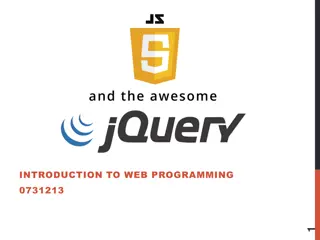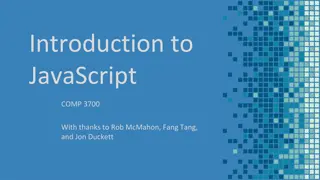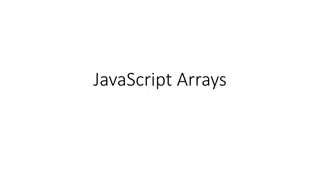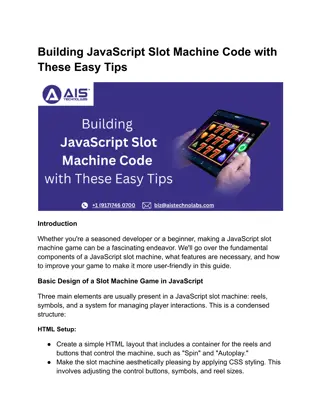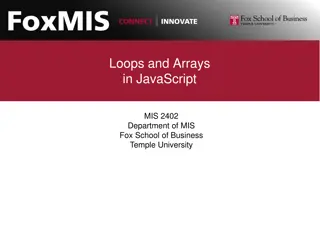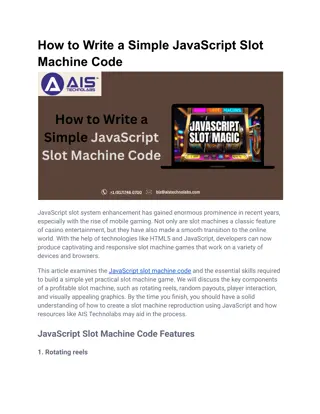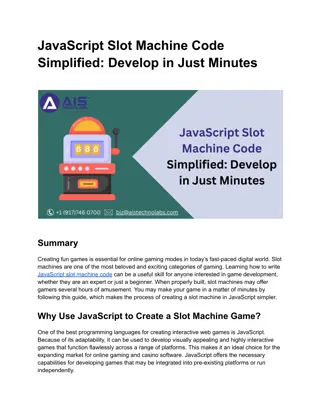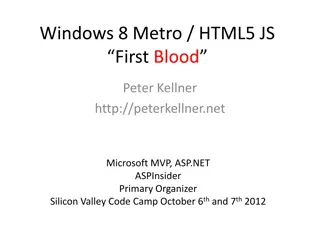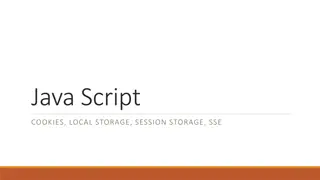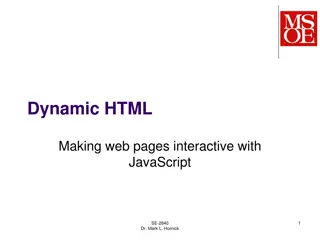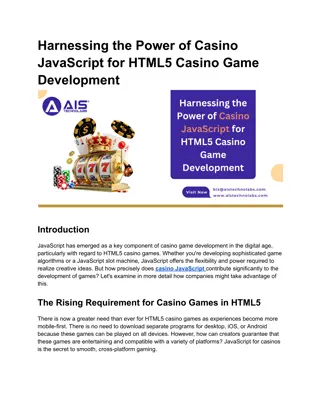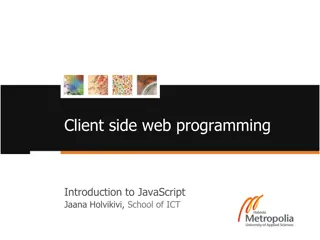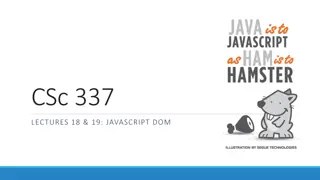Understanding JavaScript: A Brief Overview
Explore the basics of JavaScript scripting language through simple examples, stand-alone implementations, and the significance of good language design. Learn how JavaScript is widely used for web development, AJAX, and web-related applications, with a focus on its powerful modification capabilities and core programming concepts.
Download Presentation

Please find below an Image/Link to download the presentation.
The content on the website is provided AS IS for your information and personal use only. It may not be sold, licensed, or shared on other websites without obtaining consent from the author. Download presentation by click this link. If you encounter any issues during the download, it is possible that the publisher has removed the file from their server.
E N D
Presentation Transcript
Sprint 2019 JavaScript John Mitchell Adapted by Mooly Sagiv
Simple Example <!DOCTYPE html> <html> <body> <h1>My First Web Page</h1> <script> document.write("<p>My First JavaScript</p>"); </script> </body> </html>
Another Example <!DOCTYPE html> <html> <body> <h1>My First Web Page</h1> <p id="demo">My First Paragraph.</p> <script> document.getElementById("demo").innerHTM L="My First JavaScript"; </script> </body> </html>
Stand-alone implementation Spidermonkey command-line interpreter Read-eval-print loop Enter declaration or statement Interpreter executes Displays value Returns to input state Example
Why talk about JavaScript? Very widely used, and growing Web pages, AJAX, Web 2.0 Increasing number of web-related applications Adapted as a general purpose programming language Illustrates core PL concepts First-class functions Objects, in a pure form Some interesting trade-offs and consequences Powerful modification capabilities Add new method to object, redefine prototype, access caller Difficult to predict program properties in advance Challenge for programmers, implementation, security, correctness
Keys to Good Language Design Motivating application C: systems prog, Lisp: symbolic computation, Java: set-top box, JavaScript: web scripting Abstract machine Underlying data structures that programs manipulate JavaScript: web page -> document object model Theoretical considerations ECMA Standard specifies semantics of JavaScript
Whats a scripting language? One language embedded in another A scripting language is used to write programs that produce inputs to another language processor Embedded JavaScript computes HTML input to the browser Shell scripts compute commands executed by the shell Common characteristics of scripting languages String processing since commands often strings Simple program structure Avoid complicated declarations, to make easy to use Define things on the fly instead of elsewhere in program Flexibility preferred over efficiency, safety Is lack of safety a good thing? Maybe not for the Web! Small programs
JavaScript History Developed by Brendan Eich at Netscape, 1995 Scripting language for Navigator 2 Later standardized for browser compatibility ECMAScript Edition 3 (aka JavaScript 1.5) -> ES5, Related to Java in name only Name was part of a marketing deal Various implementations available Spidermonkey interactive shell interface Rhino: http://www.mozilla.org/rhino/ Browser JavaScript consoles
Motivation for JavaScript Netscape, 1995 Netscape > 90% browser market share Opportunity to do HTML scripting language Brendan Eich I hacked the JS prototype in ~1 week in May And it showed! Mistakes were frozen early Rest of year spent embedding in browser Common uses of JavaScript have included: Form validation Page embellishments and special effects Dynamic content manipulation Web 2.0: functionality implemented on web client Significant JavaScript applications: Gmail client, Google maps - ICFP talk, 2005
Design goals Brendan Eich s 2005 ICFP talk Make it easy to copy/paste snippets of code Tolerate minor errors (missing semicolons) Simplified onclick, onmousedown, etc., event handling, inspired by HyperCard Pick a few hard-working, powerful primitives First class functions for procedural abstraction Objects everywhere, prototype-based Leave all else out!
JavaScript design Functions based on Lisp/Scheme first-class inline higher-order functions function (x) { return x+1; } x. x+1 Objects based on Smalltalk/Self var pt = {x : 10, move : function(dx){this.x += dx}} Functions are also objects Lots of secondary issues In JavaScript, there is a beautiful, elegant, highly expressive language that is buried under a steaming pile of good intentions and blunders. Douglas Crockford
Sample details Which declaration of g is used? var f = function(){ var a = g(); var result = f(); function g() { return 1;}; function g() { return 2;}; var g = function() { return 3;} return a;} // what is result? var scope = global ; function f() { print(scope); var scope = local ; print(scope); } // variable initialized here //but defined throughout f
What makes a good programming language design? Architect Programmer Programming Language Compiler, Runtime environ- ment Q/A Testing Diagnosti cTools
Language syntax JavaScript is case sensitive HTML is not case sensitive; onClick, ONCLICK, are HTML Statements terminated by returns or semi-colons (;) x = x+1; same as x = x+1 Semi-colons can be a good idea, to reduce errors Blocks Group statements using { } Not a separate scope, unlike other languages (see later slide) let is supported in newer versions Variables Define a variable using the var statement Define implicitly by its first use, which must be an assignment Implicit definition has global scope, even if it occurs in nested scope
Web example: page manipulation Some possibilities createElement(elementName) createTextNode(text) appendChild(newChild) removeChild(node) Example: Add a new list item: var list = document.getElementById( list1') var newitem = document.createElement('li') var newtext = document.createTextNode(text) list.appendChild(newitem) newitem.appendChild(newtext) This example uses the browser Document Object Model (DOM) We will focus on JavaScript as a language, not its use in the browser
Web example: browser events Mouse event causes page-defined function to be called <script type="text/JavaScript"> function whichButton(event) { if (event.button==1) { alert("You clicked the left mouse button!") } else { alert("You clicked the right mouse button!") }} </script> <body onmousedown="whichButton(event)"> </body> Other events: onLoad, onMouseMove, onKeyPress, onUnLoad
JavaScript primitive datatypes Boolean Two values: true and false Number 64-bit floating point, similar to Java double and Double No integer type Special values NaN (not a number) and Infinity String Sequence of zero or more Unicode characters No separate character type (just strings of length 1) Literal strings using ' or " characters (must match) Special values null and undefined typeof(null) = object; typeof(undefined)=undefined
Type Checking Static types (Algol, C, Java, OCaml) The type of expressions are checked at compile- time Dynamic types (lisp, scheme) The type of expressions are checked at runtime Soft typing can be used Duck-Typing (Python, Ruby, Javascript) If an object can walk and swim like a duck, it is treated as a duck
JavaScript blocks Use { } for grouping; not a separate scope var x = 3; x; { var x = 4 ; x } x; Not blocks in the sense of other languages Only function calls and the with statement introduce a nested scope
JavaScript functions Declarations can appear in function body Local variables, inner functions Parameter passing Basic types passed by value, objects by reference Call can supply any number of arguments functionname.length : # of arguments in definition functionname.arguments.length : # args in call Anonymous functions (expressions for functions) (function (x,y) {return x+y}) (2,3); Closures and Curried functions function CurAdd(x){ return function(y){return x+y} }; More explanation on next slide
Function Examples Curried function function CurriedAdd(x){ return function(y){ return x+y} }; g = CurriedAdd(2); g(3) Variable number of arguments function sumAll() { var total=0; for (var i=0; i< sumAll.arguments.length; i++) total+=sumAll.arguments[i]; return(total); } sumAll(3,5,3,5,3,2,6)
Recursion var hanoi = function hanoi(disc, src, aux, dst) { if (disc > 0) { hanoi(disc -1, src, dst, aux); document.writeln( Move disc + disc + from + src + dst + dst); hanoi(disc -1, aux, src, dst) ; } } var walk_the_DOM = function walk(node, func) { func(node); node = node.firstChild; while (node) { walk(node, func); node = node.nextSibling; } }
Use of anonymous functions Simulate blocks by function definition and call var u = { a:1, b:2 } var v = { a:3, b:4 } (function (x,y) { // begin local block var tempA = x.a; var tempB =x.b; // local variables x.a=y.a; x.b=y.b; y.a=tempA; y.b=tempB }) (u,v) // end local block // Side effects on u,v because objects are passed by reference Anonymous functions very useful for callbacks setTimeout( function(){ alert("done"); }, 10000)
Objects Primitive types are immutable An object is a collection of named properties (mutable) Simplistic view in some documentation: hash table or associative array Can define by set of name:value pairs objBob = {name: Bob", grade: 'A', level: 3}; New properties can be added at any time objBob.fullname = 'Robert'; A property of an object may be a function (=method) Functions are also objects A function defines an object with method called ( ) function max(x,y) { if (x>y) return x; else return y;}; max.description = return the maximum of two arguments ;
Basic object features Creating and modifying objects function Rectangle(w, h) ={this.width=w; this.height=h;} var r = new Rectangle(8.5, 11); r. area = function () { return this.width * this.height ;} var a = r. area; Better to do it in the constructor function Rectangle(w, h) { this.width = w; this.height = h ; this. area = function () { return this.width * this.height ;} } var r = new Rectangle(8.5, 11); var a = r.area() ;
Code and data can be shared via Prototypes Each object linked to prototype object Rectangle with shared area computation function Rectangle(w, h) { this.width = w; this.height = h ; } Rectangle.prototype.area= function() { return this.width * this.height ;} var r = new Rectangle(8.5, 11); var a = r.area() ;
Inheritance Javascript supports Prototype-based programming As opposed to Java classes No need for casting Provides a reach set of code reuse patterns But syntax is ugly See Javascript the good parts
Changing Prototypes Use a function to construct an object function Car(make, model, year) { this.make = make; this.model = model; this.year = year; } Objects have prototypes, can be changed var c = new Car( Tesla , S ,2014); Car.prototype.print = function () { return this.year + + this.make + + this.model;} c.print();
Objects and this Property of the activation object for function call In most cases, this points to the object which has the function as a property (or method ) Example : var o = {x : 10, f : function(){return this.x}} o.f(); 10 this is resolved dynamically when the method is executed
JavaScript functions and this var x = 5; var y = 5; function f() {return this.x + y;} var o1 = {x : 10} var o2 = {x : 20} o1.g = f; o2.g = f; o1.g() 15 o2.g() 25 var f1 = o1.g ; f1() 10 Both o1.g and o2.g refer to the same function. Why are the results for o1.g() and o2.g() different ?
Local variables stored in scope object Special treatment for nested functions var x = 8 var o = { x: 10, f : function() { function g(){ return this.x } ; return g(); } }; o.f() function g gets the global object as its this property !
Language features Stack memory management Parameters, local variables in activation records Garbage collection Automatic reclamation of inaccessible memory Closures Function together with environment (global variables) Exceptions Jump to previously declared location, passing values Object features Dynamic lookup, Encapsulation, Subtyping, Inheritance
Stack memory management Local variables in activation record of function function f(x) { var y = 3; function g(z) { return y+z;}; return g(x); } var x= 1; var y =2; f(x) + y;
Closures Return a function from function call function f(x) { var y = x; return function (z){y += z; return y;} } var h = f(5); h(3); Can use this idea to define objects with private fields uniqueId function () { if (!arguments.callee.id) arguments.calee.id=0; return arguments.callee.id++; }; Can implement breakpoints
Implementing Closures function f(x) { function g(y) { return x + y; }; return g ; } var h = f(3); var j = f(4); var z = h(5); var w = j(7); hundefined undefined global z j w undefined undefined
Implementing Closures(1) function f(x) { function g(y) { return x + y; }; return g ; } var h = f(3); var j = f(4); var z = h(5); var w = j(7); x 3 h global z f j w g undefined undefined undefined
Implementing Closures(2) function f(x) { function g(y) { return x + y; }; return g ; } var h = f(3); var j = f(4); var z = h(5); var w = j(7); undefined x 3 h global f w g z j undefined x 4 f g
Implementing Closures(3) function f(x) { function g(y) { return x + y; }; return g ; } var h = f(3); var j = f(4); var z = h(5); var w = j(7); 8 x 3 h global f w g z j undefined x 4 f g
Implementing Closures(4) function f(x) { function g(y) { return x + y; }; return g ; } var h = f(3); var j = f(4); var z = h(5); var w = j(7); h= null; x 3 h global f w g z j 11 x 4 8 f g
Garbage collection Automatic reclamation of unused memory Navigator 2: per page memory management Reclaim memory when browser changes page Navigator 3: reference counting Each memory region has associated count Count modified when pointers are changed Reclaim memory when count reaches zero Navigator 4: mark-and-sweep, or equivalent Garbage collector marks reachable memory Sweep and reclaim unreachable memory Reference http://www.unix.org.ua/orelly/web/jscript/ch11_07.html Discuss garbage collection in connection with memory management
Exceptions Throw an expression of any type throw "Error2"; throw 42; throw {toString: function() { return "I'm an object!"; } }; Catch try { } catch (e if e == FirstException") { // do something } catch (e if e == SecondException") { // do something else } catch (e){ // executed if no match above } Reference: http://developer.mozilla.org/en/docs/ Core_JavaScript_1.5_Guide :Exception_Handling_Statements
Object features Dynamic lookup Method depends on run-time value of object Encapsulation Object contains private data, public operations Subtyping Object of one type can be used in place of another Inheritance Use implementation of one kind of object to implement another kind of object
Concurrency JavaScript itself is single-threaded How can we tell if a language provides concurrency? AJAX provides a form of concurrency Create XMLHttpRequest object, set callback function Call request method, which continues asynchronously Reply from remote site executes callback function Event waits in event queue Closures important for proper execution of callbacks Another form of concurrency use SetTimeout to do cooperative multi-tasking Maybe we will explore this in homework
Unusual features of JavaScript Some built-in functions Eval (next slide), Run-time type checking functions, Regular expressions Useful support of pattern matching Add, delete methods of an object dynamically Seen examples adding methods. Do you like this? Disadvantages? myobj.a = 5; myobj.b = 12; delete myobj.a; Redefine native functions and objects (incl undefined) Iterate over methods of an object for (variable in object) { statements } With statement ( considered harmful why??) with (object) { statements }
JavaScript eval Evaluate string as code The eval function evaluates a string of JavaScript code, in scope of the calling code Examples var code = "var a = 1"; eval(code); // a is now '1 var obj = new Object(); obj.eval(code); // obj.a is now 1 Most common use Efficiently deserialize a large, complicated JavaScript data structures received over network via XMLHttpRequest What does it cost to have eval in the language? Can you do this in C? What would it take to implement?
jQuery A JS library that simplifies programming Database like query language
Other code/string conversions String computation of property names var m = "toS"; var n = "tring"; Object.prototype[m + n] = function(){return undefined}; In addition for (p in o){....} o[p] eval(...) allow strings to be used as code and vice versa
Sample Javascript delights return { status: true }; var length = 3; console.log(lenght); What does a + b mean False values: 0, Nan, , false, null, undefined


